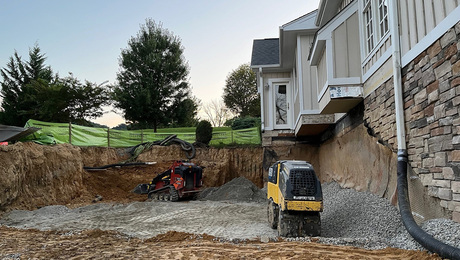Is it acceptable to lay dimensional lumber on the floor joists and then cover them with plywood and cement board for a subfloor tile base (2″). I think I can move faster laying 1×4’s or whatever, rather than dragging sheets of 3/4 and then 1/2 up three flights. I hear it’s not suitable for the base, but I wouldn’t be tiling right over it, it would have a layer of plywood and then the hardibacker over it. Any thoughts out there? RM
Discussion Forum
Discussion Forum
Up Next
Video Shorts
Featured Story

Listeners write in about ambitious projects and sinking patios before asking questions about old house specialists, attic headroom, and home shops.
Featured Video
Video: Build a Fireplace, Brick by BrickHighlights
"I have learned so much thanks to the searchable articles on the FHB website. I can confidently say that I expect to be a life-long subscriber." - M.K.

















Replies
I believe it would be faster to sheet with 4'x8'x3/4" T&G myself.
When you use 1x12s for sheathing you need run them at a diagnial, which means more custom cutting of every piece. In my opinion it's all the cutting thats eats up your time.
It is up to you as far as what you feel comfortable doing. If you have the time and are working alone then maybe thats the way to do go. I would also compare prices on 3/4 sheets and 1x.
Good Luck, Dave
Just cut the 3/4 down to managable size first. Piece them back together once they're up there. Jeff
* Jeff J. Buck/ Buck Construction/ Pittsburgh, PA *
2nd Generation Buck Const, 3rd generation Craftsman
ricky, generally board sheathing for a sub floor is about 1 x 8. If square edge it is better to run it diagonally; if it is t & g then square is acceptab;le. Cost wise it is a bit more depending on supply and availability of material. Packing plywood up the stairs can be an expensive hassel. Can you remove a window and load from a lift truck?
It would be nice if we could/would return to board sheathing, but I do not see it happening anytime soon.
david
Unless you use diagonally-laid tongue and groove boards, I would think you're guaranteeing cracked tiles and odd squeaks....that's not a mistake, it's rustic
Jeff,
Actually, when laid in a diagonal pattern, the boards have a farther span between two joists. Farther span means more board sitting in open space. More board in open space means greater chance of movement. Plywood eliminates MOST of these problems.
Square or diagonal, t & g planks make for a good, solid floor. I still prefer plywood myself, but do a lot fo work on floors with diagoanl and straight plank subfloors.
James DuHamel